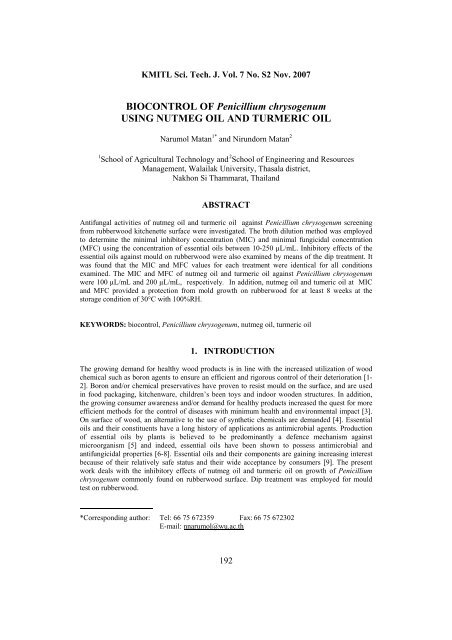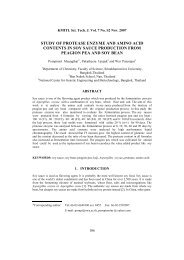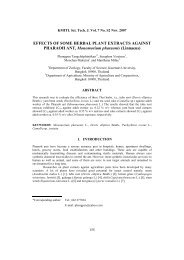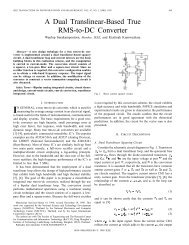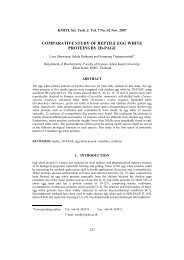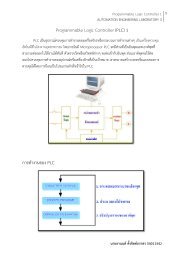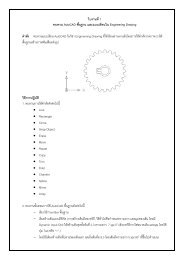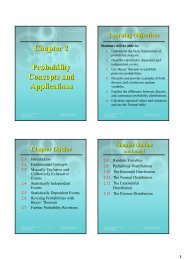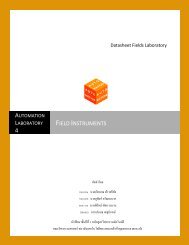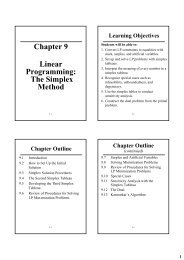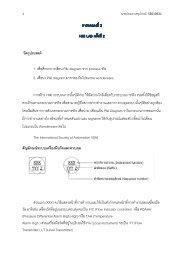BIOCONTROL OF Penicillium chrysogenum USING ... - KMIT'L
BIOCONTROL OF Penicillium chrysogenum USING ... - KMIT'L
BIOCONTROL OF Penicillium chrysogenum USING ... - KMIT'L
You also want an ePaper? Increase the reach of your titles
YUMPU automatically turns print PDFs into web optimized ePapers that Google loves.
KMITL Sci. Tech. J. Vol. 7 No. S2 Nov. 2007<strong>BIOCONTROL</strong> <strong>OF</strong> <strong>Penicillium</strong> <strong>chrysogenum</strong><strong>USING</strong> NUTMEG OIL AND TURMERIC OILNarumol Matan 1* and Nirundorn Matan 21 School of Agricultural Technology and 2 School of Engineering and ResourcesManagement, Walailak University, Thasala district,Nakhon Si Thammarat, ThailandABSTRACTAntifungal activities of nutmeg oil and turmeric oil against <strong>Penicillium</strong> <strong>chrysogenum</strong> screeningfrom rubberwood kitchenette surface were investigated. The broth dilution method was employedto determine the minimal inhibitory concentration (MIC) and minimal fungicidal concentration(MFC) using the concentration of essential oils between 10-250 µL/mL. Inhibitory effects of theessential oils against mould on rubberwood were also examined by means of the dip treatment. Itwas found that the MIC and MFC values for each treatment were identical for all conditionsexamined. The MIC and MFC of nutmeg oil and turmeric oil against <strong>Penicillium</strong> <strong>chrysogenum</strong>were 100 µL/mL and 200 µL/mL, respcetively. In addition, nutmeg oil and tumeric oil at MICand MFC provided a protection from mold growth on rubberwood for at least 8 weeks at thestorage condition of 30°C with 100%RH.KEYWORDS: biocontrol, <strong>Penicillium</strong> <strong>chrysogenum</strong>, nutmeg oil, turmeric oil1. INTRODUCTIONThe growing demand for healthy wood products is in line with the increased utilization of woodchemical such as boron agents to ensure an efficient and rigorous control of their deterioration [1-2]. Boron and/or chemical preservatives have proven to resist mould on the surface, and are usedin food packaging, kitchenware, children’s been toys and indoor wooden structures. In addition,the growing consumer awareness and/or demand for healthy products increased the quest for moreefficient methods for the control of diseases with minimum health and environmental impact [3].On surface of wood, an alternative to the use of synthetic chemicals are demanded [4]. Essentialoils and their constituents have a long history of applications as antimicrobial agents. Productionof essential oils by plants is believed to be predominantly a defence mechanism againstmicroorganism [5] and indeed, essential oils have been shown to possess antimicrobial andantifungicidal properties [6-8]. Essential oils and their components are gaining increasing interestbecause of their relatively safe status and their wide acceptance by consumers [9]. The presentwork deals with the inhibitory effects of nutmeg oil and turmeric oil on growth of <strong>Penicillium</strong><strong>chrysogenum</strong> commonly found on rubberwood surface. Dip treatment was employed for mouldtest on rubberwood.*Corresponding author: Tel: 66 75 672359 Fax: 66 75 672302E-mail: nnarumol@wu.ac.th192
KMITL Sci. Tech. J. Vol. 7 No. S2 Nov. 20072. MATERIALS AND METHODS2.1 Essential oilsNutmeg oil and turmeric oil derived by steam distillation were provided by Thai China Flavours &Fragrances Industry Co., LTD. Bangkok, Thailand.2.2 CultureMold from rubberwood kitchenette surface was identified as <strong>Penicillium</strong> <strong>chrysogenum</strong> WU 0702.This mold caused discoloration on rubberwood. Codes refer to strains held in the culture collectionof the Wood Science and Engineering Research Unit, Center for Scientific and TechnologicalEquipments, Walailak University, Nakhon Si Thammarat province, Thailand.2.3 Preparation of inoculumSpores were obtained from growing P. <strong>chrysogenum</strong> WU 0702 on malt extract agar (MEA;Merck Ltd, Thailand) medium at 30°C for 14 days and were collected by flooding the surface ofthe agar plates with ~5 ml sterile saline solution (NaCl, 8.5 g/l water) containing Tween 80 (0.1%v/v). After counting the spores using a haemocytometer, the suspension was standardized toconcentrations of 10 7 spore/ml by dilution with sterile water before using. The viability of allstrains checked using quantitative colony counts were at 10 7 CFU/ml.2.4 Inhibition of <strong>Penicillium</strong> <strong>chrysogenum</strong> WU 0702 by essential oilsDeterminations of a minimal inhibitory concentration (MIC) and a minimal fungicidalconcentration (MFC) of the oils were performed by broth dilution method in test tubes. Theessential oil of 50 µl from each of 10 to 250 µL/mL was added to 5 ml of yeast extract sucrosebroth (YES) tubes containing 10 7 spores/ml. The vegetable oil was used as a control. Differentdilutions of the oils (including controls) were made with methanol. The preliminary study revealedthat methanol had no effect on mold growth. The tubes were then incubated at 30°C for 3 days onan incubator shaker (Gallenkamp, Loughborough, England) as to evenly disperse the oilthroughout the broth . The highest dilution (lowest concentration), showing no visible growth, wasregarded as the MIC. Cells from the tubes showing no growth were subcultured on potato dextroseagar plates to determine if the inhibition was reversible or permanent. MFC was determined as thehighest dilution (lowest concentration) at which no growth occurred on the agar plates [10].2.5 Dip treatment of rubberwoodRubberwood specimens (7mm x 20mm cross section by 70 mm long) were prepared from freshlycut rubberwood lumber obtained from the plantation site in Nakhon Si Thammarat province,Thailand. The average moisture content of the rubberwood specimens before testing was 49±2 %(n=10). Sets of five random replicate specimens were dip treated according to ASTM test methodsD4445-91 [11] for 15 seconds with nutmeg oil at 100 µL/mL and turmeric oil at 200 µL/mL.Vegetable oil was used as a control. Different dilutions of the oils were made with methanol. Adip treated and vacuum treated specimens was held in a closed container overnight at roomtemperature before inoculation with spores of the test mold. Specimens were weighed before andafter the treatment to estimate the retention levels of essential oil in wood specimens. The oiltreated specimens were inoculated with 1 mL of each of mold-spore inoculum (10 7 spores/ml) andwere incubated at 30°C with 100% RH in an environmental chamber (Contherm, Petone, NewZealand) for 12 weeks. The specimens were then individually rated for mold growth on a scale of0 to 5, with 0 meaning clean specimens and 5 meaning heavy mold growth (0=clean, 1=20%,2=40%, 3=60%, 4=80%, 5=100% of mold growth) according to ASTM test methods D4445-91.Percent of stain and mold (based on control) for each essential oil concentration was calculated193
KMITL Sci. Tech. J. Vol. 7 No. S2 Nov. 2007according to Percent of stain and mold (based on control) = (A/B) x100 (When A =Total score foreach mold at each concentration of essential oil; B = Total score for each mold at control).3. RESULTS AND DISCUSSIONFungal growth inhibition was observed for both essential oils (Table 1). MIC and MFC techniqueswere employed to assess fungistatic and fungicidal properties of the oils. It was found that nutmegoil and turmeric oil had static and fungicidal effect at 100 µL/mL and 200 µL/mL, respectively.Table1 Minimum inhibitory concentration and minimum fungicidal concentration of the essentialoil against P. <strong>chrysogenum</strong>Essential oil MIC MFCNutmeg oil 100 100Turmeric oil 200 200Essential oils derived from many plants are known to possess antifungal activities [12]. Essentialoils extracted from spices and herbs are generally recognized as containing active antimicrobialcompounds [5]. Borneol, geraniol, linalool, terpineol, eugenol, myristicin, safrole, camphene,dipentene and pinene are components in nugmet oil that inhibit the growth of both bacteria andmold [13]. Nutmeg are very popular spices and commonly added to sausage and some traditionalfoods. Curcumin is active compounds in turmeric oil and possesses antimicrobial activity. Inaddition, protective effects of turmeric against aflatoxin induced liver damage has been reported inchickens [14]. Mold resistance of dip treated inoculated with P. <strong>chrysogenum</strong> are shown in Figure1. The results are presented as the average ratings of five specimens. Specimens were initiallyrated after being incubated for 1 week. Ratings continued periodically through 12 weeks or untiltest oils failed to substantially inhibit test fungi. Results of the dip method showed thatrubberwood treated with nutmeg oil was about 40% covered with mold growth at week 9 and100% covered at week 10 whereas turmeric oil inhibited P. <strong>chrysogenum</strong> WU02 for up to 8weeks and showed 100% mould coverage at week 10. Oil treatment may have some effects onmoisture exclusion, but control stakes dipped with vegetable oil showed 100% mold coverage atweek 2. From the result, nutmeg oil and turmeric oil were effective in inhibiting mold growth onrubberwood. Leaching characteristics of essential oil components from rubberwood under variousconditions is another key area that should be explored in the future.4. CONCLUSIONSNutmeg oil and turmeric oil were effective against P.<strong>chrysogenum</strong> on rubberwood dip treated withthe oils at certain period. Both of oils provided protection from mold growth on rubberwood for atleast 8 weeks at 100 µL/mL of nutmeg oil and 200 µL/mL of turmeric oil. These antifungalcompound may be useful for mould inhibition on rubberwood. Other application of essential oilson food packaging, kitchenware can be utilized.194
6080KMITL Sci. Tech. J. Vol. 7 No. S2 Nov. 2007100Stain and mold (%)4011 12020ControlNutmeg oilTurmeric oil2 3456789101Time (Week)Figure 1 Percent of stain and mold (based on control at 100 µL/mL of nutmeg oil and 200 µL/mLof turmeric oil)5. ACKNOWLEDGEMENTSThis study was supported by the Wood Science and Engineering Research Unit and the Institute ofResearch and Development, Walailak University, Thailand.REFERENCES[1] Walker, J.C.F, Butterfield, B.G., Harris, J.M., Langrish, T.A.G., and Uprichard, J.M. 1992Primary Wood Processing Principles and Practice, Chapman & Hall, London.[2] Gnanaharan, R. and Dhamodaran, T.K. 1993 A Pilot Plant Investigation of BoronTreatment of Rubberwood: Arriving at an Economical Treatment Schedule. Holz RohWerkst, 51, 279- 283.[3] Emmert, E.A. B. and Handelsman, J. 1999 Biocontrol of Plant Disease: a (Gram-) PositivePerspective, FEMS Microbiology Letters, 171(1), 1-9.[4] Yang, V.W. and Clausen, C.A. 2007 Antifungal Effect of Essential Oils on SouthernYellow Pine, International Biodeterioration & Biodegradation, 59, 302-306.[5] Burt, S. 2004 Essential Oils: Their Antibacterial Properties and Potential Applications inFoods—A Review. International Journal of Food Microbiology, 94, 223-253.[6] Matan, N and Matan, N. 2008 Antifungal Activities of Anise Oil, Lime Oil and TangerineOil Against Molds on Rubberwood (Hevea brasiliensis), International Biodeterioration &Biodegradation, 62(1), 75-78.195
KMITL Sci. Tech. J. Vol. 7 No. S2 Nov. 2007[7] Matan, N. 2007 Growth Inhibition of Aspergillus niger by Cinnamaldehyde and Eugenol,Walailak Journal of Science and Technology, 4(1), 41-51.[8] Matan, N., Rimkeeree, H. Mawson, A.J., Chompreeda, P., Haruthaithanasan, V. and Parker,M. 2006 Antimicrobial Activity of Cinnamon and Clove Oils under Modified AtmosphereConditions, International Journal of Food Microbiology, 107(2), 180-185.[9] Matan, N. 2006 Utilization of Cinnamon Oil and Clove Oil as Anitifungi in ActivePackaging for IMF Products. Kasetsart University, Bangkok, pp. 217.[10] Rasooli, I., Rezaei, M.B. and Allameh, A. 2006 Growth Inhibition and MorphologicalAlterations of Aspergillus niger by Essential Oils from Thymus eriocalyx and Thymus x-porlock, Food Control, 17, 359-364.[11] American Society for Testing and Material. 1998 Standard Test Method for Fungicides forControlling Stain and Mold on Unseasoned Lumber (laboratory method). ASTM StandardD4445-91, Vol. 11.01, West Conshohocken, pp. 497–500.[12] Valero, M. and Francés, E. 2006 Synergistic Bactericidal Effect of Carvacrol,Cinnamaldehyde or Thymol and Refrigeration to Inhibit Bacillus cereus in Carrot Broth.Food Microbiology, 23(1), 68-73.[13] Tainter, D.R. and Grenis, A.T. 2001 Spices and Seasonings (2nd ed.). John Wiley and Sons,New York.[14] Jayaprakasha, G.K., Jagan Mohan Rao, L. and Sakariah, K.K. 2005 Chemistry andBiological Activities of C. longa, Trends in Food Science and Technology, 16(12), 533-548.196


